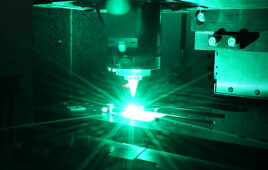Leslie Langnau/Managing Editor/Design World
Will 3D printing, also known as additive manufacturing, ever reach the stage where you can print transplantable organs? Doubtful, but ever-hopeful proponents say anything is possible. Until that day arrives, though, there are a number of medical uses in which 3D printing is making a large contribution.
The most frequent use of 3D printing is in surgical situations where 3D printers are used to print a model of the body parts that will undergo surgery. MRI and CT scan data can easily be converted into a 3D-printable file. The printer then builds a three-dimensional version of that data, delivering an accurate model of a body organ or section of a body. Surgeons can then examine that 3D model and plan the best surgical procedure.
The 3D printing industry has many examples of this application. One is that of a young child who suffered from a double aortic arch heart malformation, in which a vascular ring wrapped around the trachea and esophagus, restricting airflow. A 3D-printed model of the child’s heart enhanced the planning phase so the surgical team could visualize exactly what steps to take to correct the malfunction.
The benefits of preplanning surgeries this way are shorter surgery times and higher chances for successful outcomes.
Increasingly, 3D printing is used to develop external support structures, such as those that reduce the weight of paraplegic exoskeletons or casts for broken bones. One innovative example is the BOOMcast to support broken limbs. It was 3D-printed with embedded electronics so that a doctor can monitor the limb’s physical state from anywhere in the world.
The BOOMcast is programmed to deliver medical information to a doctor, map pressure and audio data into LED lights that convey information to the patient – and, by the way, play music from a wireless cellphone connection. BOOMcast includes four force-sensitive resistors that record the contact pressure along the leg to indicate whether the healing bone has exceeded the doctor’s recommended load-bearing conditions.
The 3D-printed body and ratcheting straps (made from FDM Nylon 12 for impact strength and durability) were built on additive manufacturing equipment including the Fortus 900mc and Objet500 Connex3 from Stratasys.
The cast enables the patient to maintain an active, enjoyable lifestyle without compromising the healing process.
Probably the third most popular use of 3D printing in medical applications is in implants. Primarily made of metal, such as titanium, implants are either permanent or semi-permanent. In some cases, the 3D-printed material serves as a scaffold to promote bone or tissue growth. Some material will eventually be absorbed by the body. In other cases, the implants replace bone removed by injury or surgery and provide structure or support.
3D printing is also a popular tool in the dental industry. It has been used to build custom braces for years and also helps dentists model teeth for crowns and other replacements.
The use of 3D printing for limb prosthetics is popular, but not necessarily functional. Stories abound about high school students creating a hand or foot prosthesis for a friend. Such a design boosts confidence in the wearer and perhaps all the attention will encourage professional prosthetic developers to look into the use of 3D printing for some parts of their designs.
While the 3D printing of organs is years away, the use of 3D printing to develop skin or other tissues for medical testing is gaining ground. It is possible to use stem cells in a special support suspension and 3D print tissue.
Lastly, research is underway to use the ability of 3D printers to precisely deposit chemicals to create medical drugs.





